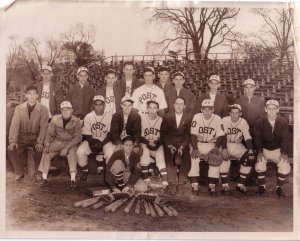
Mattapoisett Ball Club, circa 1903. Oscar Tinkham far left.
By the mid-1890s many towns along the south coast had local teams as well as professional baseball when New Bedford fielded a team in the New England League. Town teams thrived in the early 1900s and could often be the source of local entertainment for those who couldn’t make it to New Bedford to see future major league players pass through such as Napoleon Lajoie, Rabbit Maranville, Christy Matthewson and Archibald “Moonlight” Graham.
There were also local players that were well known. Once such player was Oscar Tinkham of Mattapoisett. Tinkham, a farmer by trade, was born in 1875 and most likely began playing ball at an early age. Not much is known about his early days playing baseball but by 1903 he was an established pitcher setting local records. Playing in the Buzzards Bay League for Mattapoisett he struck out 47 batters over three consecutive games.
Because Tinkham mostly played for local town teams and semi-professional leagues not many records of his playing career have survived. Most of what is know about him comes from scattered news clippings giving accounts of his performances.
On opening day in 1906, 700 people came out to watch him pitch at the Church Street Grounds in Fairhaven. Pitching for Fairhaven he struck out eight and allowed one run against his hometown team from Mattapoisett.
Many teams sought his services and it seems he played for several different teams including Mattapoisett, Fairhaven, Carver, and Taunton. In 1907, Fairhaven couldn’t come to terms with him and Middleboro made him an offer.
In addition to playing on local teams, Tinkham was sought out by at least one professional ball clubs. Tinkham pitched in at least a couple of games for the minor league New Bedford Whalers of the New England League in 1906.
The first game he pitched in was on August 24 with Tinkham facing the last place Lowell Tigers. One newspaper referring to him as “the farmer twirler”, noted he was “naturally nervous” at the outset of the game suggesting that this may have been his first professional game. However, Tinkham settled down pitching a complete game scattering eight hits and two runs while striking out eight batters and showed “coolness with men on bases.” New Bedford won 6-2 in a game that lasted an hour and forty minutes.
Tinkham pitched again on August 28 in the second game of a double header against the first place and eventual league champions, the Worcester Busters. He didn’t last long in that game pitching only two innings giving up one hit, walking two, allowing two run and committed one of New Bedford’s 3 errors that game. It isn’t clear why he was pulled after the second inning. His relief, a pitcher named Droham, was hit hard giving up nine hits and seven runs over seven innings. Needless to say New Bedford lost 9-3.

Oscar Tinkham, 1906
It isn’t known why he pitched in those games. It could have been because Tinkham was a well known local player that had set strikeout records and New Bedford, stuck in fourth place in an eight team league at the time, was looking to boost their pitching staff to become more of a contender.
It was noted that there were “worse pitchers” in the New England League than Tinkham “drawing good salaries”. But it isn’t clear if Tinkham pursued a professional career or if he even tried. He may have felt he needed to stay close to home. Just a week before his win against Lowell, Tinkham married Amy Queripel in Acushnet. The couple would have a daughter born the following March. Knowing a little one was on the way, he now had a family to provide for. With road travel and the possibility of being traded to another team or league in a city further away he may have felt an obligation to stay close now that he had a family. In addition to having a daughter he would later have two sons. Also, one news report said that Tinkham “would rather play ball than eat” but it seemed that farming was more steady work than ball playing. While playing ball wasn’t always guaranteed, Tinkam could always find work farming.
At some point as Tinkham became older he retired as a ball player and by 1923 he was living in New Bedford as a fruit dealer. Around 1923 or 1924 Tinkham was seriously ill with tuberculosis and was sent to the Bristol County Hospital in Attleboro. On the night of October 12, 1925 at 8:30 PM tuberculosis took his life. He was 50 years old.
![Memorial Day excercises, the Common, New Bedford MA [undated]. Courtesy New Bedford Whaling Museum](https://scvbb.files.wordpress.com/2015/06/undated-ceremonies-at-soldiers-and-sailors-monument.jpg?w=238&h=300)








![Rabbit_Maranville_ LC-B2- 3245-2 [P&P]](https://scvbb.files.wordpress.com/2010/05/rabbit_maranville_-lc-b2-3245-2-pp.jpg?w=300&h=220)



